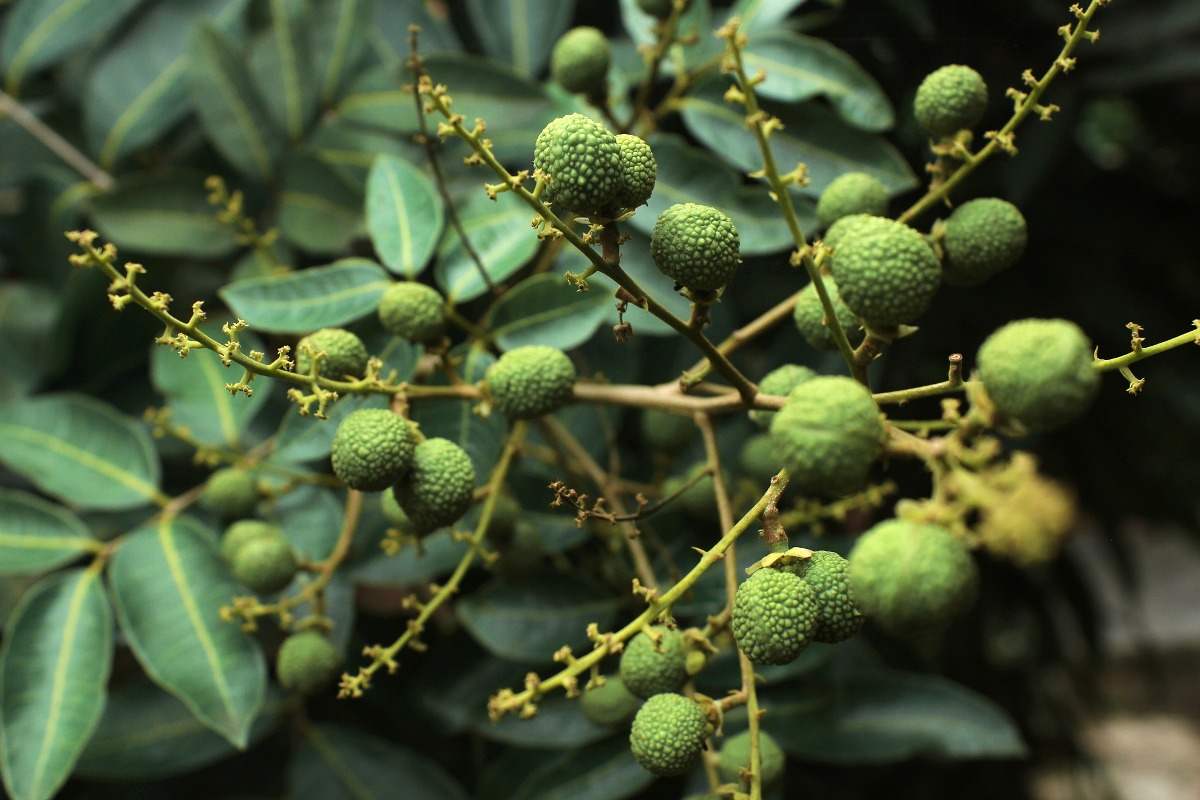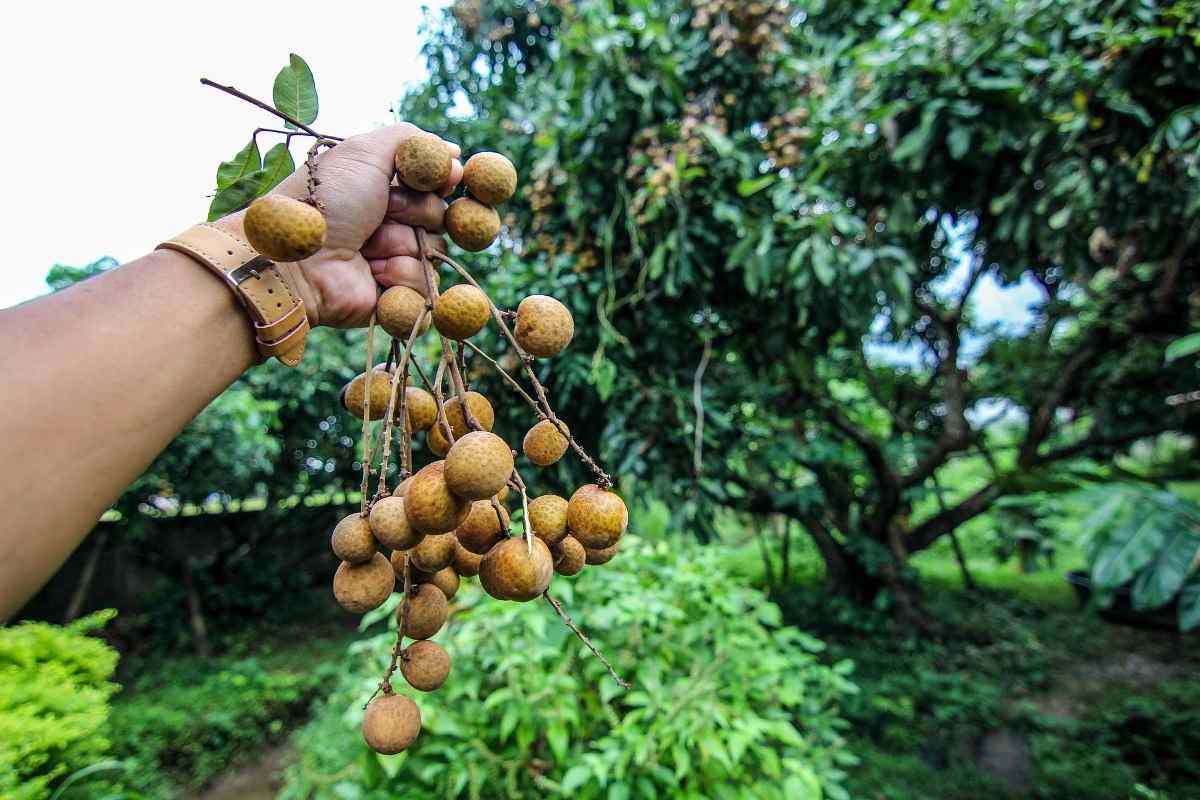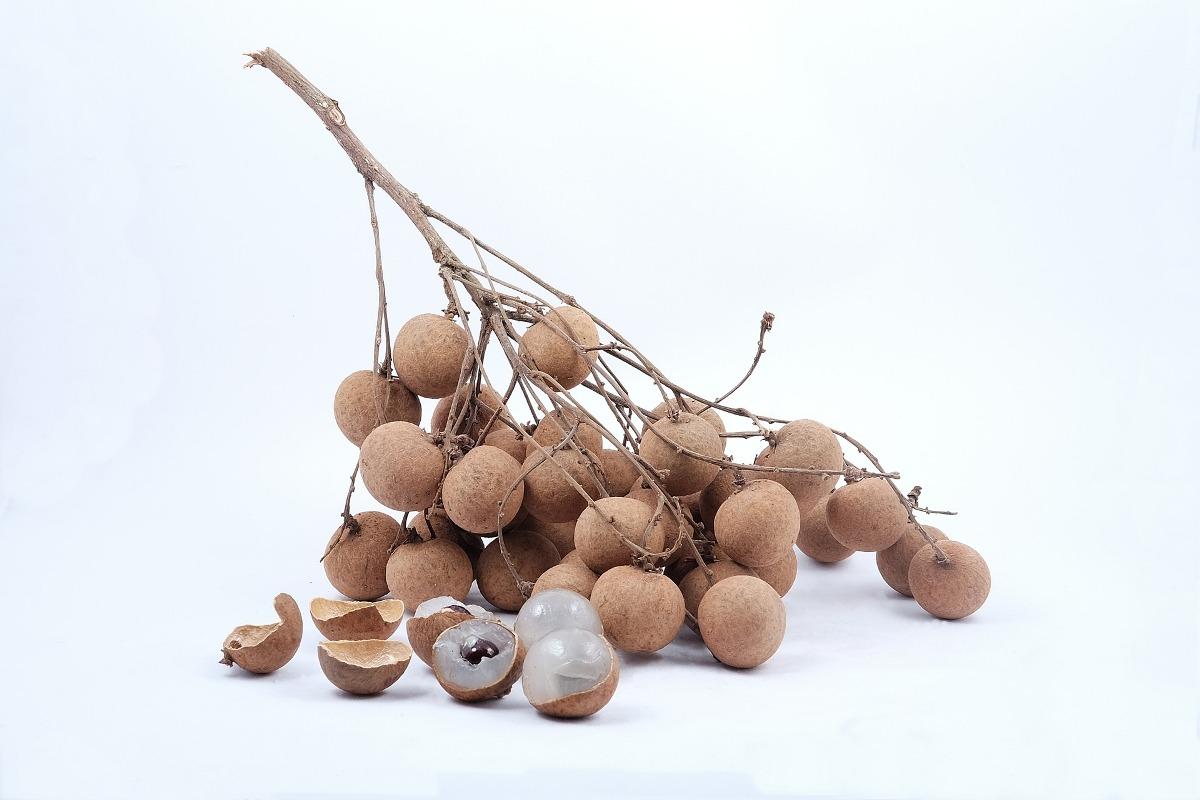Introduction to Longan fruit farming
Longan, (Dimocarpus Longan), also called lungan, tropical fruit tree of the soapberry family (Sapindaceae) and introduced into other warm regions of the world. The edible white-fleshed fruits are somewhat similar to the related lychee. The juicy flesh has a mildly sweet and musky flavor. A Longan tree is a tropical tree species that produces edible fruit.
A guide to Longan fruit farming, the cultivation process
The tree produces light-yellow inflorescences at the end of branches. The inflorescences are commonly called a panicle and are 4 to 18 inches long and widely branched. The small flowers have petals that are brownish-yellow color. Longan fruit with flesh, seed, and peel visible. The fruit hangs in drooping clusters that are circular and about 1 inch wide. The peel is tan, and leathery with tiny hairs. The flesh has a sweet taste, which can be compared to the flavor of lychee. The tree is somewhat sensitive to frost. Longan trees prefer sandy soil.
Depending upon climate and soil type the tree may grow to over 100 feet in height, but it typically stands 30 to 40 ft in height and the crown is round. The trunk is 2.5 ft thick with corky bark. The branches are long and thick, typically drooping. The leaves are oblong and blunt-tipped, usually 4–8 inches long and 2 inches wide. There are 6 to 9 pairs of leaflets per leaf and the upper surface is wavy and a dark and glossy-green.

Different varieties of Longan
There are numerous cultivars of Longan tree; however, world-wide only 30 to 40 are grown commercially. Reliable bearing is the major production problem for the Longan tree throughout the world. Several new varieties and re-introductions including ‘Edau’ (‘Daw’), ‘Chompoo’, ‘Haew’, and ‘Biew Kiew’ are under evaluation by several institutions and producers. Though, nothing superior to ‘Kohala’ has been identified. One of the recently introduced cultivars is named ‘Diamond River’ and this cultivar is reported to fruit every year. However, fruit quality is fair and the tree is very susceptible to limb breakage.
Fu yan (Lucky Eye) – Fruits are large (18g), thin skin, crisp flesh, and small seed. It is the best variety for canning.
Wu long line (Black Dragon peak) – Medium-sized fruits (15g) with thick skin, and good flesh having sweet flavor.
Wu yuan (Black Round) – Fruits are medium in size (15g), seed large, and the flesh soft and juicy.
Daw – Fruit is large with big seed, thin skin, and crisp sweet flesh.
Soil and climate requirement for Longan fruit farming
Longan trees thrive on various soil types provided they are well-drained and they do well on sandy loams, sand, and calcareous, rocky soils.
Longan tree is a subtropical tree well adapted to tropical climates with distinctive wet or dry periods and subtropical areas with a cool, nonfreezing fall or winter period. Longan plants grow at elevations from sea level to 1500 feet. Longan plants produce more reliably in areas characterized by low non-freezing temperatures (15°C or less) and a dry period during the fall and winter (October–February). Warm temperatures 21 to 29°C during spring, followed by high summer temperatures 27 to 35°C and non-limiting soil moisture are best for fruit development.
Warm and rainy winters are conducive to vegetative growth and reduce flowering and Longan fruit production. Excessive rains during flowering cause flower drop and reduce pollination and fruit set. Young Longan plant leaves are sensitive to strong winds during vegetative flushing which may result in leaf dehydration, browning, and deformation.
Longan tree propagation
Longan trees may be grown from seed, however, cultivars do not come true from seed, and the fruit of inferior quality. Seedlings can be used for the selection of new cultivars or rootstocks. Air layering is the most common propagation method. April through August is the best time for air layering method, and roots form within 10 to 12 weeks. Grafting onto seedling rootstock can be done by side veneer or cleft grafting. Seedlings are grafted when pencil size (8 mm) or larger stem diameter. Trees can be top-worked by grafting onto selected vigorous shoots. Trees may be propagated by cuttings with mist and bottom heat.
Longan trees are mostly grown from seed. After drying in the shade for 4 days, they must be planted without delay, but no more than 2 cm deep, otherwise they may send up more than one sprout. Germination takes place within 7 to 10 days. The seedlings are transplanted to shaded nursery rows the following spring and set in the field 2 to 3 years later during winter dormancy.
In case if you miss this: Cold Storage Subsidy, Loan, and Business Plan.
Longan plants can be propagated from seed, air-layering, budding, grafting, cutting, and inarching. Longan propagation by seed is not advisable since the seedling takes a long time to bear fruit (7-8 years) and the planting material is not true to type. Vegetative propagations are the recommended means of propagating the planting material. Among the vegetative propagations, air layering is the most popular method and has been widely used for a long time. This process yields a high percentage of successful planting material as the marcotted branches produce roots readily. Claims of success rates of about 80 to 90 percent with air-layering are very common.
Longan plant spacing
Longan trees grow fast and at maturity are large trees. Homeowners should plant Longan trees about 22 to 25 ft or more away from other trees and structures. Longan trees planted too close to other trees or structures may not grow normally or produce much fruit due to shading.
The planting process of Longan
Properly planting a Longan tree is one of the most important steps in successfully establishing and growing a strong and productive tree. The first step is to select a healthy nursery tree. Commonly, nursery Longan trees are grown in 3-gallon containers and trees stand about 2 to 4 ft (0.6–0.9 m) from the soil media. Large trees in smaller containers must be avoided as the root system may be “root bound”. This means all the available space in the container has been filled with plant roots to the point that the root system becomes compacted within the container. Rootbound root systems could not grow properly once planted in the ground.
Longan trees are best planted at the beginning of the wet season. Planting holes of about 60 x 60 x 60 cm are dug and allowed to weather for about two weeks before planting. If the planting materials are planted in polybags, make sure the bags are removed at the time of planting. Organic manure and phosphate fertilizer both can be incorporated into the soil to be used to fill the planting hole. Compact the soil after planting to ensure that there is firm contact between the root system and soil mass. The plant must be firmly staked and tied to avoid been blown over by the strong wind. Tree spacing ranges from 6 x 6 m to 12 x 12 m; giving tree densities ranging from 70 to 300 trees/hectare. Inspect the tree for insect pests and diseases and inspect the trunk of the Longan tree for wounds and constrictions. Choose a healthy tree and water it regularly in preparation for planting in the ground.
Process of growing a Longan tree
- Plant Longan tree in well-drained, slightly acid soil in full sun, at least 25 feet away from other trees or buildings. Plant it on a small hill or mound if winters are wet.
- Make your hole 3 times the depth and diameter of the young tree’s root ball. Shovel some of the loose soil back into the hole and position the Longan tree so that it grows at the same height or slightly higher than it did in the pot.
- Cut the Longan tree back to 4 feet if it is taller than that. Water it deeply and then apply a couple of inches of mulch. Give it 1/2 cup of organic fertilizer every few months in the spring and summer season, and continue to water the tree frequently while it is small.
- Choose 3 or 4 of the strongest shoots the following spring and prune off the others. Then, cut those shoots back by a few inches and use weights or wedges to force them into a more horizontal position if necessary. Then, prune off all but two shoots on each branch in the third spring.
- Cut back on water during the fall and winter after the tree reaches fruit-bearing age about 4 years for trees propagated from cuttings and six years for trees grown from seed. Give the tree 5 pounds of organic fertilizer just before it blooms in early spring, again in late spring, and once more just before harvesting the fruits in late summer. Refrain from fertilizing your Longan tree during the fall or winter.
- Watch for panicles of small greenish-yellow blossoms in early spring. Wait for the Longan fruits to change from chartreuse to tan before you harvest them. Taste one first to make sure it is ready before picking the others because they won’t continue to ripen after they are removed from the tree.
- Snip off each cluster with pruning shears and refrigerate the fruits in plastic bags until you are ready to use them.
Training, pruning, and manuring for Longan fruit farming
Early growth is to be encouraged to get a good Longan tree size and canopy within 3-4 years. Frequent irrigation and regular application of nutrients will help this. Organic manures like poultry manure must be supplemented with fertilizers like Urea. The trees must be trained to get food light penetration through the canopy. Each tree must be earthed up to make a mound. Irrigation is given to encourage bud burst. Before flower emergence, it must be withheld. And, again irrigation is to be continued from panicle emergence, flowering, fruit set, harvest, and post-harvest flushing. Again when the tree undergoes a rest period, irrigation must be stopped. Just like irrigation, the fertilizer application should also be done 3 to 4 times during the different growth periods in a year. For a five-year-old tree about 625gN, 150g P and 800 g K have to be applied and increased by 20% every year till the 10th year.
The water requirement in Longan fruit farming
Keep the soil of the young tree moist and when the Longan tree starts to produce flowers, water regularly till it bears fruit. Excessive rains during flowering cause flower drop and reduce pollination. Established trees must be irrigated regularly from the signs of blooming appear and until harvest. The use of sprinklers on a timer can result in overwatering, causing root rot and decline. Warm-season and rainy winters encourage vegetative growth and reduce flowering.
Pests and diseases affected in Longan tree
A range of pests can afflict the Longan tree, including mites, scales, fruit flies, aphids, stem borers, leaf and flower eating caterpillars, mealybug, and fruit piercing moth. Birds and flying foxes are attracted to Longan fruits. After planting, irrigate Longan plants regularly to establish. Once Longan trees begin to bear (3 to 4 years after planting), water regularly only in spring and summer season, when they’re flowering and bearing fruit.
Harvesting and yield in Longan fruit farming
You may also check this: Organic Chilli Cultivation, Farming Practices.

The Longan fruits have a leathery brown skin which is easily broken. The flesh is aromatic, sweet, and moist, and few people don’t like eating this fruit out of-hand. It can be frozen for prolonged periods and preserved without any loss of quality. Longan fruits are harvested after full maturity and ripening. Harvested fruit must be cooled as soon as possible. Longan fruit has a relatively short shelf-life; place your harvest in a plastic bag and it must keep in the refrigerator for 5 to 7 days. A fully mature tree yields about 100 – 120 kg /year. The Longan fruits can be stored for 4-6 weeks at 5°C.
Commonly asked questions about Longan fruit farming

How much time does it take for a Longan tree to bear fruit?
Seedling trees take up to 6 years to bear fruit; whereas air layered trees can bear fruit 2 to 3 years after planting. In general, Longan trees bear erratically (i.e., not every year) and some years little to no fruit is produced.
Can I grow Longan from seed?
Most Longan trees have been grown from seed and the seeds lose viability quickly. After drying in the shade for 4 days, they must be planted without delay, but no more than 3/4 inches deep, otherwise they may send up more than one sprout. Seed germination takes place within a week or 10 days.
How often do you water a Longan tree?
Irrigate a Longan tree once a week, but only if it did not rain 1 inch of water during that week. Stop watering a Longan tree in late summer after harvesting the Longan fruit.
Why my Longan tree is leaves turning yellow?
Deficiency of iron, manganese, and magnesium in Longan fruit trees causes foliage to turn yellow. Sometimes the fertilizers used in Longan trees also contain herbicides that cause foliage to yellow and thicken. Nutrient deficiencies are common in Longan trees growing in overly alkaline or poorly drained soil.
In case if you are interested in this: Fruit Juice Making Business in India.
My longan plant is stuck for 1 months time. I bought the plant from nursery and planted it on ground. Fertilized with organic fertilizers. But it’s stuck where I bought it. The leaves are not turning yellow, it’s just staying as it is when I bought it 1 month back. I tried adding some additional fertilizers like vermi compost, slurry with ground nut cake, micro nutrients and mocorizza. But no effect, please advise. I’m from Kerala, India.